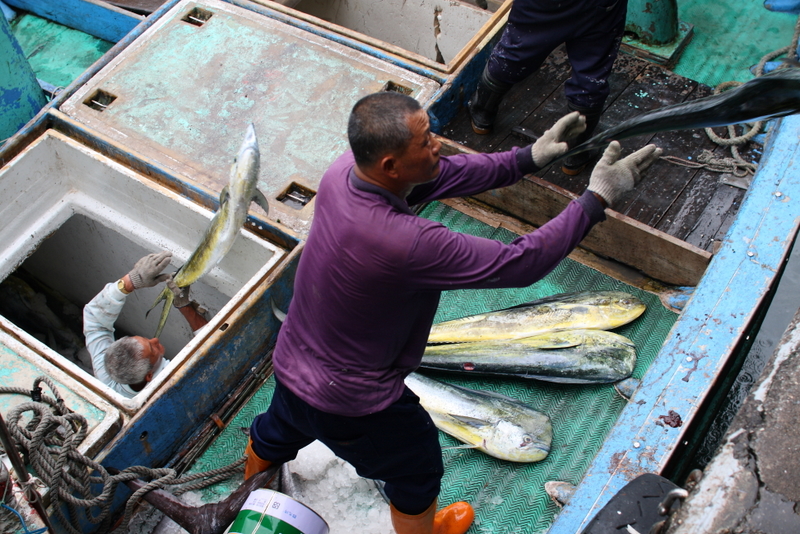●Basic fishery information
|
Unit of Assessment |
Description |
|
Target species (Common name and scientific name) |
Mahi-mahi(dolphinfish; Coryphaena hippurus) |
|
Fishery location |
Taiwan EEZ and the High Seas of the Pacific Ocean |
|
Gear type |
Longline |
|
Catch quantity (weight) |
|
|
Vessel type |
Small scale tuna longliners |
|
Number of registered vessels |
188 |
|
Management authority |
Taiwan Fisheries Agency |
The Kuroshio Current (black tide) transports warm, tropical water northward and passes through the offshore waters in eastern Taiwan, which contributes to an environment that attracts plenty and various fish species and brings abundant catch for the local fishermen, and mahi mahi is one of them.
Mahi mahi (coryphaena hippurus), also known as dolphin fish or dorado, is a highly migratory species. Mahi mahi grows very fast, and it can reach its sexual maturity in 6 months (body length about 60 centimeters). Its lifespan is about 4 to 5 years in average. The size of male mahi mahi is usually larger than female one. It usually stays in pelagic sea area and feeds on pelagic fish species, such as sardine and flying fish. Its preferred habitat is tropical and subtropical waters (about 25-28°C), so it mostly migrates along with the Kuroshio Current, and therefore becomes an important marine living resource with economic value in eastern Taiwan. There are two distinct fishing seasons for mahi mahi: one is from April to June and the other is from September to November. The amount of catch is higher in the first fishing season.
Most Taiwanese fishing vessel harvesting mahi mahi can be found in Hsin-Kang of Taitung, Nan-Fang Ao of Yilan, and Dong-Kang of Pingtung. Chenggong Fishing Harbor of Chenggong Town in Taitung County, also known as Hsin-Kang Fishing Harbor, is a major fishing harbor in eastern Taiwan. Most fishing vessels based in Hsin-Kang are fishing vessels smaller in size or fishing rafts. Nan-Fang-Ao Fishing Harbor of Yilan is one of three major fishing ports in Taiwan – fishing vessels harvesting mahi mahi range from GT 10 and 100. Dong-Kang Fishing Harbor of Pingtung is an important fishing harbor for Taiwan distant water fishery industry – longline fishing vessels participating in the FIP are those ranging from GT 20 and 100.
Mahi mahi is mostly caught by longline, but some of the fishing vessels would use troll line in the water. Fishermen usually use live milkfish, frozen Pacific saury and squid as bait, and employ a highly selective hook, which is locally called four-angle hook, to catch mahi mahi. The major fishing ground is in the eastern Taiwan sea area, but each captain would decide the location of fishing operation based on his own experience, mostly in the area between 20°N to 25°N.
In general, most of the Hsin-Kang and Su-Ao mahi mahi fishing vessels would return to the harbor for landing daily, but sometimes some bigger vessel (for example fishing vessels from Dong-Kang) may spend 5-7 days for one trip. For fishing vessels that return daily usually leave port before midnight (10-11 pm). To better preserve the catch, Hsin-Kang fishermen have developed their unique procedures to maintain the freshness of the fish, so as to have a better price.
In order to secure a better fishing location. After arriving the chosen location, the captain and crew onboard would have a simple meal and start to prepare fish bait and fishing gear. Most of the time, fishing vessel would start to deploy the longline at 3-4 am, while most people are sleeping in bed.
The duration of longline deployment would be different in accordance with the number of hooks to be deployed. It usually takes two hours to complete the deployment. After longline is deployed, the captain and crew would take some rest before they start to retrieve the fishing gear. The duration of hauling may be different at each operation, based on the amount of the catch in this set. Of course, when the catch condition is good, the duration of hauling would be longer. It is quite often to spend more than ten hours to finish the hauling. Sometimes, if the duration of hauling is longer than expectation, it will lead to the fishing vessel unable to enter port before fish auction, therefore, some fishing vessels would choose to stay at sea for next fishing set.
According to the fisheries statistics annual report in 2020, the amount of mahi mahi caught in the offshore and coastal area was 4,300 metric tons, worth New Taiwan Dollars 270 million dollars. During the fishing season, one fishing vessel may catch more than one thousand kilogram of catch in one day. Therefore, for local fishermen, mahi mahi is a very important economic resource to ensure their livelihood. In order to conserve this important fish resource, the Hsin-Kang Fishermen Association, service wholesaler, processing plants, fish trade agent, and local fishermen have jointly initiate the Hsin-Kang mahi mahi FIP. It is hoped that through the implementation of the FIP, this fish resource can be conserved and managed in a good manner, thus all the stakeholders can sustainably engage in this fishery.

